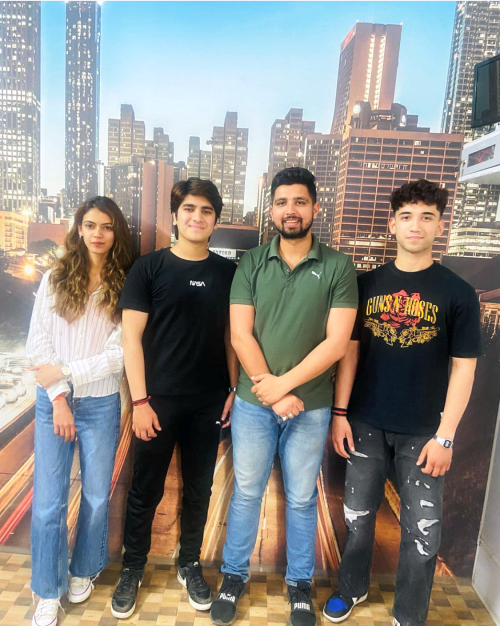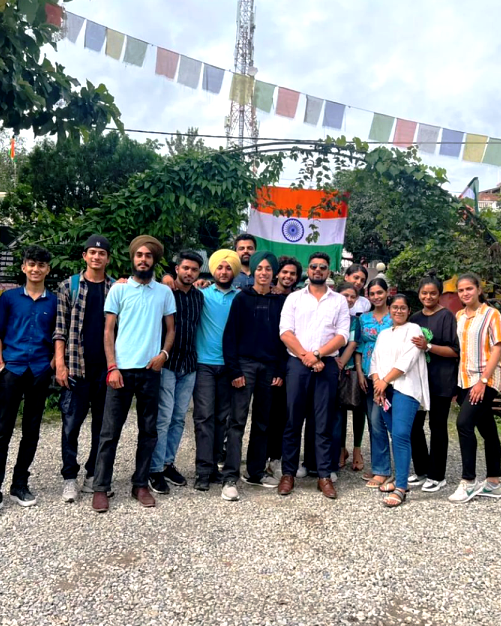Section 1:Language courses
Questions 1-8: Matching information with correct courses
[The rules for finding answers to this sort of question are simple. Just find the keywords and read around different courses carefully. Then, give a quick look to check whether there is another information or idea provided by the same course in the text. If there is, check the reference carefully and decide your answer. Remember, the questions may not follow any sequential order.]
Question 1: Which advertisement mentions
up-to-date teaching systems?
Keywords for this question: up-to-date, teaching systems,
Have a close look at advertisement B.
Here, LATEST METHODS = up-to-date teaching systems,
So, the answer is: B
Question 2: Which advertisement mentions
that the institution has been established for a significant time?
Keywords for this question: established, for a significant time,
In advertisement E, have a close look at the first bullet point.
Here, more than 24 years’ experience = established for a significant time,
So, the answer is: E
Question 3: Which advertisement mentions
examination classes?
Keywords for this question: examination classes,
Again, in advertisement E look at the second bullet point.
Here, Test preparation = examination classes,
So, the answer is: E
Question 4: Which advertisement mentions
that arrangements can be made for activities outside class?
Keywords for this question: arrangements, activities outside class,
In the lower side of advertisement C, we find the mention of activities outside class in point no. 3.
Here, Study Tours Available = arrangements for activities outside class,
So, the answer is: C
Question 5: Which advertisement mentions
the availability of courses for school students?
Keywords for this question: courses for school students,
Take a look at point no. 3 at advertisement D.
Here, High School Crash Course = courses for school students,
So, the answer is: D
Question 6: Which advertisement mentions
language teaching for special purposes?
Keywords for this question: language teaching, special purposes,
Advertisement B talks about language teaching for special purposes.
Here, BUSINESS, HOSPITALITY OR TRAVEL = special purposes,
So, the answer is: B
Question 7: Which advertisements mention
a wide variety of language choices?
Keywords for this question: wide variety, language choices,
Both Advertisements A and B mention a wide variety of language choices.
Here, *Mandarin, * Cantonese, *Thai, *Vietnamese, *Korean, *Indonesian, *English, *Spanish, *Italian, *German, *Russian = a wide variety of language choices,
Here, CHOICE OF 9 LANGUAGES = a wide variety of language choices,
So, the answer is: A, B
Question 8: Which advertisements mention
evening classes?
Keywords for this question: evening classes,
Both advertisements B and D contain information about evening classes.
Here, DAY AND EVENING COURSES = day and evening classes,
Here, morning or evening = day and evening classes
So, the answer is: B, D
Questions 9-13: MAIN STREET, GATTON RE-DEVELOPMENT
Questions 9-13: TRUE, FALSE, NOT GIVEN
[In this type of question, candidates are asked to find out whether:
The statement in the question agrees with the information in the passage – TRUE
The statement in the question contradicts the information in the passage – FALSE
If there is no information on this – NOT GIVEN
For this type of question, you can divide each statement into three independent pieces and make your way through with the answer.]
Question 9: The road will be closed for two days and not re-opened until Monday.
Keywords for this question: road, will be closed, two days, not re-opened, until Monday,
Let’s have a look at the first paragraph. “The next stage in the re-development of the roads in the town of Gatton will mean that Main Street will be closed between Little and Denning Streets from 6am on Saturday, 12 August to 6pm on Sunday, 13 August. The intersections of these streets with Main Street will not be affected.”
Here, from 6am on Saturday, 12 August to 6pm on Sunday, 13 August mean that the road will be closed for two days and re-open from Monday.
So, the answer is: FALSE
Question 10: The road will be open as far as Little Street.
Keywords for this question: road, will be open, as far as, Little Street,
Again, the first paragraph gives us the answer to this question. “The next stage in the re-development of the roads in the town of Gatton will mean that Main Street will be closed between Little and Denning Streets from 6am on Saturday, 12 August to 6pm on Sunday, 13 August. The intersections of these streets with Main Street will not be affected.”
Here, The intersections of these streets with Main Street will not be affected = the road will be open s far as Little Street,
So, the answer is: TRUE
Question 11: Work on the road will continue each weekend for the next month.
Keywords for this question: work, will continue, each weekend, next month,
The answer can be traced in the first and second paragraphs of the notice.
In the first paragraph, the writer says, “The next stage in the re-development of the roads in the town of Gatton will mean that Main Street will be closed between Little and Denning Streets from 6am on Saturday, 12 August to 6pm on Sunday, 13 August. The intersections of these streets with Main Street will not be affected.” This means work on the road will continue for two days.
Then, in the second paragraph, the writer says, “We expect that the work will be completed at this time without further disruption to traffic.”
Here, the work will be completed at this time = it will need only two days to complete the re-development work; NOT each weekend for the next month.
So, the answer is: FALSE
Question 12: Temporary traffic lights will operate at intersections with Main Street.
Keywords for this question: temporary traffic lights, will operate, intersections, Main Street,
There is no mention of any temporary traffic lights in this notice.
So the answer is: NOT GIVEN
Question 13: There will be bus services to the university throughout the weekend.
Keywords for this question: bus services, to the university, throughout the weekend,
The answer lies in paragraph no. 4 where the writer says, “No university bus services will operate through the area between Little and Denning Streets. However, alternative services will operate on bus routes 566 and 45 between Gatton Road, the town centre and the university.”
This means there will be alternative bus services to the university throughout the weekend.
So the answer is: TRUE
Section 2:Ashwood College
Questions 14-20: TRUE, FALSE, NOT GIVEN
[In this type of question, candidates are asked to find out whether:
The statement in the question agrees with the information in the passage – TRUE
The statement in the question contradicts the information in the passage – FALSE
If there is no information on this – NOT GIVEN
For this type of question, you can divide each statement into three independent pieces and make your way through with the answer.]
Question 14: Overseas students must pay a deposit when they apply for a course at the college.
Keywords for this question: overseas students, must pay, deposit, when, apply,
At the top of the enrolment details, we can see the condition for overseas students. It says,
“How to enrol if you are abroad . . .
Please complete the Application Form and send this with the correct Non-Returnable Deposit (see below) to: The Overseas Registrar, Ashwood College, 20 Glossop Street, Midhaven. . . .”
Here, abroad = overseas, Non-Returnable Deposit = the deposit that overseas students must pay,
So the answer is: TRUE
Question 15: Outstanding fees are payable by the end of the first week of the course.
Keywords for this question: outstanding fees, payable, by the end, first week,
Take a look at the bottom of the enrolment details.
Here, in the ‘Deposits/payment’ section, take a look at point no. 2,
“2. Any balance of course and accommodation fees must be paid in full by the first day of your course.”
So, the answer is: FALSE
Question 16: Classes are organised according to ability level.
Keywords for this question: classes, organised, ability level,
Take a look at the bottom of the enrolment details.
Here, in the ‘Location and Time of Courses’ section, take a look at lines 3-5, “Before entry to the school, students must take an entry test to determine the level of class they enter. .. . .”
Here, entry test to determine the level of class they enter = classes are organised according to ability level,
So, the answer is: TRUE
Question 17: There is a break between each lesson.
Keywords for this question: break, between, each lesson,
Again, at the bottom of the enrolment details, have a look at the first point of the ‘Conditions’ section.
“Timetable
Each hour consists of 50 minutes’ tuition and a 10-minute break.”
This line suggests that there is a 10-minute break between each lesson.
So, the answer is: TRUE
Question 18: Students may change courses at any time during the term.
Keywords for this question: students, may change courses, any time, during, term,
This text does not contain any information about changing courses during term.
So, the answer is: NOT GIVEN
Question 19: Any student is permitted to take a week’s holiday during a 12-week course.
Keywords for this question: any student, permitted, take, week’s holiday, during, 12-week course,
Again, at the bottom of the enrolment details, take a look at the ‘Student Holidays’ section,
“Students on long courses except examination preparation courses may take a holiday of one week every 12 weeks without losing their course fee for this period.”
Here, except examination preparation courses = students in examination preparation courses cannot take holiday,
So, the answer is: FALSE
THE TOTARA LANGUAGE INSTITUTE NEW ZEALAND
Questions 20-26: Summary completion:
[In this kind of questions candidates are given a summary for one, two or three paragraphs with some fill in the blanks questions. Candidates need to find out the related paragraphs by correctly studying the keywords from the questions. Then, they should follow the steps of finding answers for fill in the gaps.]
Example question: Overseas students who study at _____ may choose to spend more of their free time .. . .. .
Example answer: Totara Language Institute
Question 20: with local students by applying for a room in the _________ .
Keywords for this question: local students, by applying, for, room, in the,
Take a close look above the first big paragraph. The author says here, “Choice of accommodation for all students – homestays with local families or in Halls of Residence with New Zealand students.”
Here, Choice of accommodation = room, New Zealand students = local students,
So, the answer is: (University) Halls of Residence
Question 21: Places are available here even for students enrolled on the minimum length course of _________.
Keywords for this question: places, available, even for students, enrolled, minimum length course,
In the beginning of the text, take a look at the points given.
“Study English in a national university with students from many countries.
- 4-week blocks”
Here, 4-week blocks = minimum length course – 4 weeks,
Also, in the first paragraph, look at lines 2-3, “ .. . .. Intensive English classes are taught in four-week blocks throughout the year and students may enrol for as many blocks as they wish. … .”
So, the answer is: 4/ four weeks
Question 22: Class sizes for each course range from _________ students and all the class teachers are well qualified; many of them teach on graduate programmes in areas such as applied linguistics.
Keywords for this question: class sizes, each course, range from, all the class teachers, well qualified,
In the first paragraph, the writer says in lines 7-8, “ . .. .. Classes are small, usually from 10-12 students with a maximum number of 15, and normally contain a mix of students from a wide range of countries. … .. .”
Here, from 10 = minimum 10 students, maximum number of 15 = maximum 15 students,
So, the range of students is 10-15.
So, the answer is: 10-15 / ten to fifteen
Question 23: As a member of the Language Institute you will automatically be able to join the ________.
Keywords for this question: as, member, will automatically, be able to join,
Lines 8-9 of the first paragraph say, “ . . . . Students who study English at the Language Institute become international members of the Waikato Students’ Union. … .. .”
Here, Students who study English = As a member, become = will automatically be able to join,
So, the answer is: (Waikato) Students’ Union
Questions 24 & 25: Hamilton can offer students a wide range of social activities. The city itself lies on either side of the 24. ________ which results in some very 25. ________ views and enjoyable walks in the gardens.
Keywords for this question: Hamilton, offer, wide range, social activities, city, lies on, either side of, results in, some very, views, enjoyable walks, gardens,
The first few lines of the second paragraph say, “Hamilton, one of New Zealand’s fastest growing cities, is ideally located for a wide range of leisure and cultural activities. The Waikato river, the longest river in New Zealand, flows through the centre of the city, providing a picturesque and park-like setting of riverside walks and gardens.
Here, leisure and cultural activities = social activities, flows through the centre of the = the city itself lies on either side of the river, providing = results in,
So, the answers are:
- (Waikato) river
- picturesque
Question 26: The Institute employs an activities co-ordinator who can help you organise your free time and you may also wish to make use of this service for planning your ________ when you leave New Zealand. Remember that a student permit is not valid when you have finished your studies.
Keywords for this question: Institute, employs, activities co-ordinator, help, organise, free time, may also wish, make use, for planning, when, leave New Zealand,
In the final paragraph, the author of the text says in lines 1-3, “The Language Institute activities co-ordinator can assist students to arrange any sport and leisure activities. Assistance is also available for ongoing travel arrangements for students. Students on a visitor visa or work permit may study for a maximum of 3 months. .. .. .”
Here, assist = help, arrange any sport and leisure activities = organise your free time, wish to make use of this service = assistance is also available,
So, the answer is: (ongoing) travel (arrangements)
Section 3:
Questions 27: Multiple choice questions: Choosing the best title
[This type of question asks you to choose a suitable answer from the options using the knowledge you gained from the passage. Generally, this question is set found as the last question set in most passages so you should not worry much about it. Finding all the answers for previous questions gives you a good idea about these questions.]
Tips: Always answer this question at the end. Never answer it first in the exam.
Question 27: From the list below choose the most suitable title for the whole of the Reading Passage. Write the appropriate letter A-D in box 27 on your answer sheet.
A. Pollution control in coal mining
B. The greenhouse effect
C. The coal industry and the environment
D. Sustainable population growth
Keywords for this answer: most suitable title,
The passage mainly talks about the coal industry and its effect in the environment.
So, the answer is: C (The coal industry and the environment)
Questions 28-31: List of headings
[In this question type, IELTS candidates are provided with a list of headings, usually identified with lower-case Roman numerals (i, ii, iii, etc,). A heading will refer to the main idea of the paragraph or section of the text. Candidates must find out the equivalent heading to the correct paragraphs or sections, which are marked with alphabets A, B, C and so forth. Candidates need to write the appropriate Roman numerals in the boxes on their answer sheets. There will always be two or three more headings than there are paragraphs or sections. So, some of the headings will not be used. It is also likely that some paragraphs or sections may not be included in the task. Generally, the first paragraph is an example paragraph which will be done for the candidates for their understanding of the task.
Tips to answer this question: Don’t read the list of headings first. Have a quick look at the questions, and go straight to the first question and start reading the paragraph associated with it. Skimming is the best reading technique. You need not understand every word here. Just try to gather the gist of the sentences. That’s all. Read quickly, and don’t stop until you finish each sentence.]
Question no. 28: Section A
Section A contains two paragraphs.
First, look at the first line of the first paragraph, “Coal is expected to continue to account for almost 27 per cent of the world’s energy needs. .. …”
Then, look at the final line of the second paragraph, “ . .. .. Such measures are helping coal to maintain its status as a major supplier of the world’s energy needs.”
So, the answer is: v (Coal as an energy source)
Question no. 29: Section B
Section B contains four paragraphs and each of the paragraphs talks about ‘greenhouse effect’.
Take a look at the topic sentence, which is the very first line, “The coal industry has been targeted by its critics as a significant contributor to the greenhouse effect. .. ..”
So, the answer is: vi (Coal and the enhanced greenhouse effect)
Question no. 30: Section C
In section C, we find two paragraphs and each of them focuses on ‘research and development’. Look closely at the very first line, “The world-wide coal industry allocates extensive resources to researching and developing new technologies and ways of capturing greenhouse gases. .. ..”
So, the answer is: vii (Research and development)
Question no. 31: Section D
Section D contains four paragraphs and each of the paragraphs focuses on some measure to protect the environment.
Take a look at lines 2-5, “ … .. . By carefully pre-planning projects, implementing pollution control measures, monitoring the effects of mining and rehabilitating mined areas, the coal industry minimises the impact on the neighbouring community, the immediate environment and long-term land capability.”
Here, pollution control measures = environment protection measures,
So, the answer is: iv (Environment protection measures)
Questions 32-36: Multiple choice questions
[This type of question asks you to choose a suitable answer from the options using the knowledge you gained from the passage. Generally, this question is set found as the last question set in most passages so you should not worry much about it. Finding all the answers for previous questions gives you a good idea about these questions.]
Question no. 32: The global increase in greenhouse gases has been attributed to –
Keywords for this question: global increase, greenhouse gases, attributed to,
In section B, take a look at the first lines of paragraph no. 3, “Greenhouse gases arise from a wide range of sources and their increasing concentration is largely related to the compound effects of increased population, improved living standards and changes in lifestyle. .. .. .”
Here, increased population, improved living standards and changes in lifestyle = trends in population and lifestyle,
So, the answer is: D (trends in population and lifestyle)
Question no. 33: The proportion of all greenhouse gases created by coal is approximately –
Keywords for this question: proportion, all greenhouse gases, created by coal, approximately,
Again, in section B, the final lines of paragraph no. 4 say, “ .. . . . Coal’s total contribution to greenhouse gas emissions is thought to be about 18 per cent, with about half of this coming from electricity generation.”
Here, Coal’s total contribution to greenhouse gas emissions = The proportion of all greenhouse gases created by coal,
So, the answer is: B (18 per cent/18%)
Question no. 34: Current research aims to increase the energy-producing efficiency of coal by –
Keywords for this question: current research, aims to increase, energy-producing efficiency, coal, by,
In section C, the first paragraph says, “The world-wide coal industry allocates extensive resources to researching and developing new technologies and ways of capturing greenhouse gases. Efficiencies are likely to be improved dramatically, and hence CO2 emissions reduced, through combustion and gasification techniques which are now at pilot and demonstration stages.”
Here, now at pilot and demonstration stages = current research … . . developing,
So, the answer is: B (developing new gasification techniques)
Question no. 35: Compared with ordinary coal, new, ‘clean’ coals may generate power –
Keywords for this answer: compared, ordinary coal, new, ‘clean’ coals, generate power,
The final paragraph of section C talks about ‘clean’ coals. Here, the writer says, “Clean coal is another avenue for improving fuel conversion efficiency. .. . .”
Here, improving fuel conversion efficiency = generate power more cleanly and more efficiently,
So, the answer is: A (more cleanly and more efficiently)
Question no. 36: To control dust at mine sites, mining companies often use –
Keywords for this question: to control, dust, mine sites, mining companies, often use,
In section D lines 13 of paragraph no. 2, he author of the test writes, “Dust levels are controlled by spraying roads and stockpiles, and water pollution is controlled by carefully separating clean water runoff from runoff which contains sediments or salt from mine workings. .. .. .”
So, the answer is: D (runoff water containing sediments)
Questions 37-40: YES, NO, NOT GIVEN
In this type of question, candidates are asked to find out whether:
The statement in the question matches with the claim of the writer in the text- YESThe statement in the question contradicts with the claim of the writer in the text- NOThe statement in the question has no clear connection with the account in the text- NOT GIVEN
[TIPS: For this type of question, you can divide each statement into three independent pieces and make your way through with the answer.]
Question no. 37: The coal industry should be abandoned in favour of alternative energy sources because of the environmental damage it causes.
Keywords for this question: coal industry, should be abandoned, favour, alternative energy sources, because, environmental damage,
In section A, the first paragraph talks about the importance of the coal industry and why it should not be abandoned. “Coal is expected to continue to account for almost 27 per cent of the world’s energy needs. However, with growing international awareness of pressures on the environment and the need to achieve sustainable development of energy resources, the way in which the resource is extracted, transported and used is critical.”
Here, critical = extremely important,
So, the answer is: NO
Question no. 38: The greatest threats to the environment are the gases produced by industries which support the high standard of living of a growing world population.
Keywords for this question: greatest threats, environment, gases, support, high standard, living, growing world population,
The first paragraph in section B talks about the greatest threats to the environment which are the different greenhouse gases. “The coal industry has been targeted by its critics as a significant contributor to the greenhouse effect. However, the greenhouse effect is a natural phenomenon involving the increase in global surface temperature due to the presence of greenhouse gases – water vapour, carbon dioxide, tropospheric ozone, methane and nitrous oxide – in the atmosphere. Without the greenhouse effect, the earth’s average surface temperature would be 33-35 degrees C lower, or -15 degrees C. Life on earth, as we know it today, would not be possible.”
Here, the lines clearly state that greenhouse gases support the high standard of living of the growing population on the earth.
So, the answer is: YES
Question no. 39: World population in the twenty-first century will probably exceed 8 billion.
Keywords for this question: world population, twenty-first century, will probably, exceed, 8 billion,
In section B, in the third paragraph, take a look at lines 3-4, “ . . .. From a current base of 5 billion, the United Nations predicts that the global population may stabilise in the twenty-first century between 8 and 14 billion, .. . ..”
Here, between 8 and 14 billion = exceed 8 billion,
So, the answer is: YES
Question 40: CFC emissions have been substantially reduced in recent years.
Keywords for this question: CFC emissions, substantially reduced, recent years,
In the fourth paragraph of section B, the writer talks about CFC emissions. However, no information is given about the reduction of CFC emissions in recent years.
So, the answer is: NOT GIVEN








